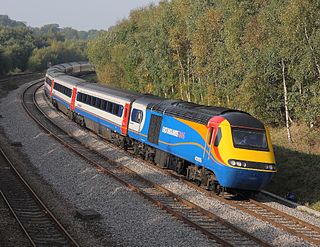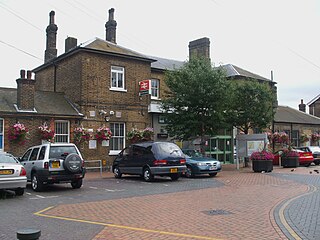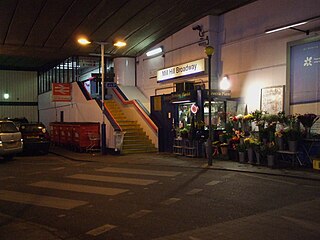
Thameslink is a 24-hour main-line route in the British railway system, running from Bedford, Luton, St Albans City, Peterborough and Cambridge via central London to Sutton, Orpington, Sevenoaks, Rainham, Horsham, Brighton, East Grinstead, and Littlehampton. The network opened as a through service in 1988, with severe overcrowding by 1998, carrying more than 28,000 passengers in the morning peak. All the services are currently operated by Govia Thameslink Railway.

High Speed 1 (HS1), legally the Channel Tunnel Rail Link (CTRL), is a 67-mile (108 km) high-speed railway linking London with the Channel Tunnel.

The Midland Main Line is a major railway line in England from London to Sheffield in Yorkshire via the East Midlands. It comprises the lines from London's St Pancras station via Leicester, Derby/Nottingham and Chesterfield.

The Northern City Line is a commuter railway line in England, which runs from Moorgate station to Finsbury Park in London with services running beyond. It is part of the Great Northern Route services, and operates as the south-eastern branch of the East Coast Main Line (ECML). It is underground from Moorgate to Drayton Park in Highbury, from which point it runs in a cutting until joining the ECML south of Finsbury Park. Its stations span northern inner districts of Greater London southwards to the City of London, the UK's main financial centre. Since December 2015, its service timetable has been extended to run into the late evenings and at weekends, meeting a new franchise commitment for a minimum of six trains per hour until 23:59 on weekdays and four trains per hour at weekends.

St Pancras railway station, also known as London St Pancras or St Pancras International and officially since 2007 as London St Pancras International, is a central London railway terminus on Euston Road in the London Borough of Camden. It is the terminus for Eurostar services from Belgium, France and the Netherlands to London. It provides East Midlands Railway services to Leicester, Corby, Derby, Sheffield and Nottingham on the Midland Main Line, Southeastern high-speed trains to Kent via Ebbsfleet International and Ashford International, and Thameslink cross-London services to Bedford, Cambridge, Peterborough, Brighton, Horsham and Gatwick Airport. It stands between the British Library, the Regent's Canal and London King's Cross railway station, with which it shares a London Underground station, King's Cross St Pancras.

King's Cross Thameslink station is a closed railway station in central London, England. It is located on Pentonville Road, around 250 metres (0.2 mi) east of King's Cross mainline station. At the time of closure, in 2007, it was served by Thameslink trains and managed by First Capital Connect.

Moorgate is a central London railway terminus and connected London Underground station on Moorgate in the City of London. Main line railway services for Hertford, Welwyn Garden City, Stevenage and Letchworth are operated by Great Northern, while the Underground station is served by the Circle, Hammersmith & City, Metropolitan and Northern lines.

Kentish Town is a London Underground and National Rail station in Kentish Town in the London Borough of Camden. It is at the junction of Kentish Town Road (A400) and Leighton Road. It is in Travelcard Zone 2. The station is served by the High Barnet branch of the London Underground Northern line, and by Thameslink trains on the National Rail Midland Main Line. It is the only station on the High Barnet branch with a direct interchange with a National Rail line; furthermore an Out of Station Interchange (OSI) with Kentish Town West on the North London line is not charged as two separate journeys in electronic journey charging.

The East Coast Main Line (ECML) is a 393-mile long (632 km) electrified railway between its southern terminus at London King's Cross station and Edinburgh Waverley via Peterborough, Doncaster, York, Darlington, Durham and Newcastle. The line is a key transport artery on the eastern side of Great Britain running broadly parallel to the A1 road. The main line acts as a 'spine' for several divergent branches, serving destinations such as Cambridge, Leeds, Hull, Sunderland and Lincoln, all with direct services to London, in addition, a few ECML services extend beyond Edinburgh to serve Glasgow Central, although the principal London-Glasgow route is the West Coast Main Line (WCML)

Herne Hill railway station is in the London Borough of Lambeth, South London, England, on the boundary between London fare zones 2 and 3. Train services are provided by Thameslink to London Blackfriars, Farringdon, St Pancras International and St Albans on the Thameslink route and by Southeastern to London Victoria and Orpington on the Chatham Main Line. It is 3 miles 76 chains (6.4 km) down the line from Victoria.
A train operating company (TOC) is a business operating passenger trains on the railway system of Great Britain under the collective National Rail brand. TOCs have existed since the privatisation of the network under the Railways Act 1993.

The Brighton Main Line is a major railway line in the United Kingdom that links Brighton, on the south coast of England, with central London. In London the line has two branches, out of London Victoria and London Bridge stations respectively, which join up in Croydon and continue towards Brighton as one line. The line is electrified throughout using the third rail system.

The North Kent Line is a railway line which branches off the South East Main Line at St Johns junction west of Lewisham station in Greater London and runs to Rochester Bridge Junction near Strood, Medway where it links to the Chatham Main Line.

Norwood Junction railway station is a National Rail station in South Norwood in the London Borough of Croydon, south London and is in Travelcard Zone 4. It is 8 miles 55 chains down the line from London Bridge.

Mill Hill Broadway railway station is on the Midland Main Line in England, serving the suburb of Mill Hill in the London Borough of Barnet, north London. It is 9 miles 28 chains (15.0 km) down the line from St Pancras and is situated between Hendon to the south and Elstree & Borehamwood to the north. Its three-letter station code is MIL.
The Southern Region was a region of British Railways from 1948 until 1992 when railways were re-privatised. The region ceased to be an operating unit in its own right in the 1980s. The region covered south London, southern England and the south coast, including the busy commuter belt areas of Kent, Sussex and Surrey. The region was largely based upon the former Southern Railway area.

The Great Northern route is the name given to suburban rail services run on the southern end of Britain's East Coast Main Line and its associated branches. Services operate to or from London King's Cross and London Moorgate in London. Destinations include Hertford North, Welwyn Garden City, Stevenage, and Cambridge, and in peak hours, additional services run to Peterborough and King's Lynn. Services run through parts of Greater London, Hertfordshire, Bedfordshire, Cambridgeshire, and Norfolk.

The Thameslink Programme, originally Thameslink 2000, was a £6 billion project in south-east England to upgrade and expand the Thameslink rail network to provide new and longer trains between a wider range of stations to the north and to the south of London. The development facilitated new cross-London journeys, which means that passengers no longer have to change trains in London. Work included platform lengthening, station remodelling, new railway infrastructure, and new rolling stock. The project was originally proposed in 1991 following the successful introduction of the initial Thameslink service in 1988. After many delays, planning permission was granted in 2006 and funding was approved in October 2007. Work started in 2009 and was completed on 18 September 2020, although trains over the new routes began running in 2018.
The East Coast Main Line Route Utilisation Strategy (RUS), published by Network Rail in February 2008, was the seventh RUS.

The Bermondsey dive-under is a significant piece of rail infrastructure to the south of London Bridge Station in Bermondsey, London. A dive-under is where one set of rail lines tunnel under another set instead of crossing them on the level, this allows for independent running and increases the capacity of both tracks. For historical reasons, Bermondsey was a point of congestion where tracks from Kent heading to Charing Cross station had to cross the tracks coming from Sussex and running north to terminate at London Bridge or through to Blackfriars.

















